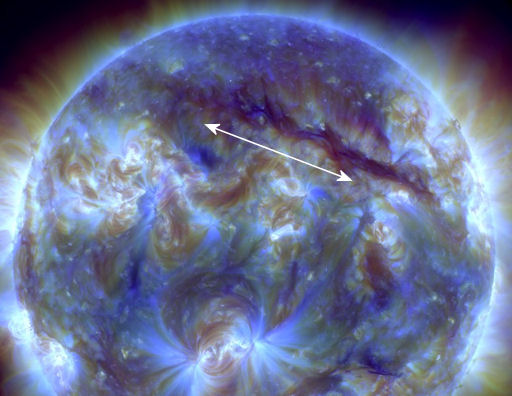
+15
orthodoxymoron
Sanicle
lawlessline
Floyd
Jenetta
HigherLove
arvan33
Brook
We Are You
gscraig
TRANCOSO
CetaceousOne
Mercuriel
Micjer
Carol
19 posters
SOHO LASCO C2 Latest Image

Carol- Admin

- Posts : 31699
Join date : 2010-04-07
Location : Hawaii
- Post n°51
 Re: SOHO LASCO C2 Latest Image
Re: SOHO LASCO C2 Latest Image

_________________
What is life?
It is the flash of a firefly in the night, the breath of a buffalo in the wintertime. It is the little shadow which runs across the grass and loses itself in the sunset.
With deepest respect ~ Aloha & Mahalo, Carol

Carol- Admin

- Posts : 31699
Join date : 2010-04-07
Location : Hawaii
- Post n°52
 Re: SOHO LASCO C2 Latest Image
Re: SOHO LASCO C2 Latest Image
Two significant coronal mass ejections (CMEs) occurred in less than two days (Nov. 12-14, 2011) as observed by STEREO's Ahead COR 2 coronagraph. The first event is a halo CME event in that the leading edge of the particle cloud expanded in an arc around the Sun. The cloud was headed right towards the Ahead spacecraft. In the second, larger event the bright cloud is heading out into space and away from Earth. The Sun, represented by the white circle, is blocked out by a black disk so that faint features in the corona can be observed. The bright object moves into the field of view in the lower right is Mercury.
_________________
What is life?
It is the flash of a firefly in the night, the breath of a buffalo in the wintertime. It is the little shadow which runs across the grass and loses itself in the sunset.
With deepest respect ~ Aloha & Mahalo, Carol

Carol- Admin

- Posts : 31699
Join date : 2010-04-07
Location : Hawaii
- Post n°53
 Re: SOHO LASCO C2 Latest Image
Re: SOHO LASCO C2 Latest Image
Electrical power grid to be blasted by 2012 solar storms
This article was written in '09 by Michael Salla
This article was written in '09 by Michael Salla
A report issued by the National Research Council (NRC) in January 2009 has warned of the far reaching consequences of a solar storm hitting the Earth as the sun becomes more active during solar cycle 24 which began in 2008 and peaks around 2012. A March 23 article in the New Scientist discussed the significance of the NRC report which details how a solar storm could wipe out the electrical power grid causing massive disruption in the U.S. and around the planet. The impact of the plasma energy directly bombarding the Earth during a solar storm could lead to electrical power stations being off line for weeks and months at a time, as overworked workers try to repair badly damaged electrical equipment. According to the NRC report, this would lead to “disruption of the transportation, communication, banking, and finance systems, and government services; the breakdown of the distribution of potable water owing to pump failure; and the loss of perishable foods and medications because of lack of refrigeration.” Imagine life without running water from a tap, no refrigeration for storing food, gas for your car, or mass transit due to the power grid being off line for months. Millions of Americans could subsequently die in such a scenario described by Michael Brooks author of the New Scientist article, “Space storm alert: 90 seconds from catastrophe.” Such disturbing scenarios are very possible according to the National Research Council report. Now is the right time for bold action to replace the outdated electrical power grid with a decentralized form of fuelless or 'new energy' generators that can be mass produced for homes, small businesses and essential services.
A workshop was convened on May 22-23, 2008 by the Committee on the Societal and Economic Impacts of Severe Space Weather to “consider both direct and collateral effects of severe space weather events, the current state of the space weather services infrastructure in the United States, the needs of users of space weather data and services, and the ramifications of future technological developments for contemporary society's vulnerability to space weather.” The panel of scientists that met and issued a report warning about the impact of a severe solar storm hitting the Earth based their findings on data concerning the sun becoming more active around 2012. At the time of their meeting, they did not consider what was later revealed by NASA on December 16, 2008 to be a giant hole in the Earth’s magnetosphere that will last the entire 11 year duration of cycle 24. What this means is that the low possibility discussed by the May 2008 panel for solar storms impacting the Earth, is in fact much more likely to occur around 2012 as the sun become increasingly active. Indeed, the increased possibility of solar storms directly impacting the Earth due to the magnetosphere breach will last for the next ten years.
The National Research Council report and the December 2008 NASA announcement concerning a rip in the magnetosphere, together point to severe solar storms directly impacting the Earth and taking out the electrical power grid for extended periods of time around 2012, or collapsing altogether. Therefore, the U.S. and other nations have only two or three years to prepare for life where a centralized electrical power grid become increasingly unreliable or disappears altogether. The need for an alternative electrical power supply for the U.S. and the planet has never been more urgent. Fortunately, a possible solution was supplied by an early 20th century inventor.
An innovative attempt to develop power generators independent of the centralized electrical grid based fossil fuels are found in patents developed by the great inventor, Nikola Tesla (1856-1943). Tesla claimed that he could harness energy from the environment to power electrical devices. He said in 1933:
This new power for the driving of the world's machinery will be derived from the energy which operates the universe, the cosmic energy, whose central source for the earth is the sun and which is everywhere present in unlimited quantities.”
On November 5, 1901, Tesla was granted his first patent for his 'free' or 'new energy' device which he called: "Apparatus for the Utilization of Radiant Energy." Many inventors, inspired by Tesla’s theories and patents, have claimed they have been able to replicate and improve on his basic models. Numerous research papers have been written supporting the feasibility of Tesla’s ideas and patents.
Unfortunately, many inventors of 'free energy' generators and supporters of Tesla’s ideas have been harassed or intimidated by unknown government agencies and/or corporate entities opposed to creation of such devices. Fuelless energy generators threaten vested interests dependent on conventional fossil fuels for providing electricity to the general public. A number of non-governmental initiatives are underway to support inventors wanting to develop new energy generators. These include the New Energy Movement, the New Energy Congress and the Orion Project, all of which are privately funded and seeking public assistance. The time has arrived where inventors and organizations seeking the creation of new energy generators need to be supported. The alternative is to watch the centralized electrical power system become increasingly unreliable and even collapse as solar storms sweep over the planet as Solar Cycle 24 moves into its active phase. President Obama needs to urgently support an ambitious plan to develop and supply American families, small business and essential services with small scale new energy generators.
Continue reading on http://www.examiner.com/exopolitics-in-honolulu/electrical-power-grid-to-be-blasted-by-2012-solar-storms#ixzz1ej3NKwW7
Cost of electric grid failure from 2012 solar storms avoidable
According to a report issued by the National Research Council (NRC) in January 2009 a large solar storm can cause severe disruption to the U.S. electrical grid. In a severe solar storm, electrical transformers can be melted causing power blackouts for extended periods. Repairs to the damaged electrical grid, according to a New Scientist article published in March 2009, could span from several weeks or months up to ten years. Also, there is no guarantee that repaired electrical grids would not again succumb to new solar storm activity as Solar Cycle 24 reaches its maximum over a several year period around 2012. There was some good news in NASA scientists recently revising estimates of solar activity for Solar Cycle 24 to the lowest levels since 1928. Nevertheless, a giant breach in the magnetosphere reported by NASA in December 2008 makes it far easier for solar plasma to enter into the Earth’s atmosphere. For the full 11 year period of Solar Cycle 24 (approx. 2008-2019) the Earth will be vulnerable to any Coronal Mass Ejections directly aimed at it from the sun. The risks of solar storms bombarding the Earth and repeatedly taking down the electrical grid for extended periods has never been greater. In addition to physical and health risks posed by extensive and repeated electrical blackouts, the economic costs would be enormous. Now is the best time to take preventative action and develop off-the-grid (stand alone) energy systems using renewable energy sources.A presentation at the 2008 Space Weather Workshop was titled “Economic Aspects of Space Weather on the Power Grid.” The author, Ben Damsky, estimated the financial cost of moderate, large and very large space storms disrupting the electrical grid of an American city with a population of one million. Damsky’s approach was based on a city losing 80% of its share of the U.S. Gross National Product for the number of working days lost when a very large storm hit. To get a more accurate idea of the financial cost for the period in question, I will use an economic forecast for the state of Hawaii from 2009-2012 using figures cited by the Hawaii State Department of Business, Economic Development & Tourism, issued on May 18, 2009.
In 2012, the State of Hawaii is estimated to have a population of 1.3 million and a Gross Domestic Product of 69 billion. This averages out at $53,000 per person and $1.3 billion per week. If a very large solar storm were to hit and take down the electric grid and cause an 80% loss of revenue, this would equate to just over 1 billion dollars a week. The revenue lost over a month would be a staggering 4 billion dollars. Hawaii would be worse hit than other U.S. states due to its reliance on tourism. Over 7 million visitors are expected to visit Hawaii in 2012 and spend 13 billion dollars. If Hawaii’s electric grid were to go out, few tourists would visit leading to a loss of most if not all of the tourist revenue for the black out period. Consequently, businesses would experience severe financial losses, revenue from state sales and accommodation taxes would decline greatly, etc. Hawaii, like most U.S. states, would be very severely hit by prolonged and/or repeated black outs. What’s the solution for Hawaii and other government authorities in the U.S. and the world?
One solution is to encourage off-the-grid energy production so that individuals, businesses and government agencies can become energy self-sufficient. A variety of independent energy production technologies have lately become more feasible. These include photovoltaic cells and wind energy which rank high among renewable energy sources. In Hawaii and other U.S. states a number of small companies have begun developing off the grid capacities. One Maui based company, Smart Roof Systems, specializes in solar and wind off-the grid energy systems.
2 Evergreen Solar panels 180 watts each, Tristar 60Amp Controller, 2, 400 watt Air-x wind generators, about 8 marine deep cycle batteries from walmart now. A 250A DC breakerbox from Midnight Solar, Xantrex DR-2412 2400Watt Inverter, and a Reliance transfer switch. So far the system has cost about $6,000 with everything overbuilt to be upgradeable with more solar panels.
Continue reading on Examiner.com Cost of electric grid failure from 2012 solar storms avoidable - Honolulu exopolitics | Examiner.com http://www.examiner.com/exopolitics-in-honolulu/cost-of-electric-grid-failure-from-2012-solar-storms-avoidable#ixzz1ej4aVagl
_________________
What is life?
It is the flash of a firefly in the night, the breath of a buffalo in the wintertime. It is the little shadow which runs across the grass and loses itself in the sunset.
With deepest respect ~ Aloha & Mahalo, Carol

Carol- Admin

- Posts : 31699
Join date : 2010-04-07
Location : Hawaii
- Post n°54
 Re: SOHO LASCO C2 Latest Image
Re: SOHO LASCO C2 Latest Image
Solar radiation storm and shock wave sends CME towards Earth

November 26, 2011 – RADIATION STORM: A minor radiation storm is in progress. The protons making up this storm were accelerated toward Earth by shock waves in a CME that left the sun around 0700 UT on Nov. 26th. This event could have an effect on high-latitude HF radio communication. A solar wind flowing from the southern coronal hole (above) could reach Earth as early as Nov. 29. Solar wind speed is currently 364 km/sec with a proton density reading of 4.3 protons/cm3 –Space Watch
_________________
What is life?
It is the flash of a firefly in the night, the breath of a buffalo in the wintertime. It is the little shadow which runs across the grass and loses itself in the sunset.
With deepest respect ~ Aloha & Mahalo, Carol

Mercuriel- Admin

- Posts : 3497
Join date : 2010-04-07
Location : Walking the Path...
- Post n°55
 Re: SOHO LASCO C2 Latest Image
Re: SOHO LASCO C2 Latest Image

Oooooyeah - Upgrade Inbound...

_________________
Namaste...
Peace, Light, Love, Harmony and Unity...

Carol- Admin

- Posts : 31699
Join date : 2010-04-07
Location : Hawaii
- Post n°56
 Re: SOHO LASCO C2 Latest Image
Re: SOHO LASCO C2 Latest Image

Space Weather Alerts and Warnings Timeline

_________________
What is life?
It is the flash of a firefly in the night, the breath of a buffalo in the wintertime. It is the little shadow which runs across the grass and loses itself in the sunset.
With deepest respect ~ Aloha & Mahalo, Carol

CetaceousOne- Posts : 261
Join date : 2010-04-10
Location : Phoenix, AZ
- Post n°57
 Re: SOHO LASCO C2 Latest Image
Re: SOHO LASCO C2 Latest Image
I think this latest round started to hit yesterday afternoon, local time.
I started feeling like crap and my insides decided to liquefy themselves!
In other words, the usual when there is an incoming light surge.
YaY!
I started feeling like crap and my insides decided to liquefy themselves!
In other words, the usual when there is an incoming light surge.
YaY!

TRANCOSO- Posts : 3930
Join date : 2010-04-10
Location : AMSTERDAM
- Post n°58
 Re: SOHO LASCO C2 Latest Image
Re: SOHO LASCO C2 Latest Image
CetaceousOne wrote:I think this latest round started to hit yesterday afternoon, local time.
I started feeling like crap and my insides decided to liquefy themselves!
In other words, the usual when there is an incoming light surge.
YaY!
Just your usual daily hangover, Cetaceous...
 Nothinhg to worry about...
Nothinhg to worry about... 
Carol- Admin

- Posts : 31699
Join date : 2010-04-07
Location : Hawaii
- Post n°59
 Re: SOHO LASCO C2 Latest Image
Re: SOHO LASCO C2 Latest Image
CME IMPACT: As predicted by analysts at the Goddard Space Weather Lab, a coronal mass ejection (CME) hit Earth's magnetic field at approximately 2145 UT on Nov. 28th. The impact was weaker than expected, but it still produced bright auroras around the Arctic Circle:

SINUOUS SUNSPOTS: A line of sunspots stretching across the sun's northern hemisphere appears to be an independent sequence of dark cores. A telescope tuned to the red glow of solar hydrogen, however, reveals something different. The sunspots are connected by sinuous filaments of magnetism:
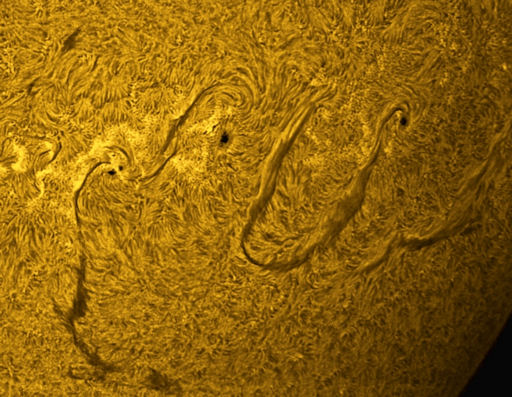 "These sunspots writhe and squirm energetically as they rotate away from us!" says John Nassr, who took the picture on Nov. 28th from his backyard observatory in Baguio, the Philippines.
"These sunspots writhe and squirm energetically as they rotate away from us!" says John Nassr, who took the picture on Nov. 28th from his backyard observatory in Baguio, the Philippines.
The connections suggest an interesting possibility. While each sunspot individually poses little threat for strong solar flares, an instability in one could start a chain reaction involving all, leading to a widespread eruption. Readers with solar telescopes are encouraged to monitor developments.

SINUOUS SUNSPOTS: A line of sunspots stretching across the sun's northern hemisphere appears to be an independent sequence of dark cores. A telescope tuned to the red glow of solar hydrogen, however, reveals something different. The sunspots are connected by sinuous filaments of magnetism:

The connections suggest an interesting possibility. While each sunspot individually poses little threat for strong solar flares, an instability in one could start a chain reaction involving all, leading to a widespread eruption. Readers with solar telescopes are encouraged to monitor developments.
_________________
What is life?
It is the flash of a firefly in the night, the breath of a buffalo in the wintertime. It is the little shadow which runs across the grass and loses itself in the sunset.
With deepest respect ~ Aloha & Mahalo, Carol

Carol- Admin

- Posts : 31699
Join date : 2010-04-07
Location : Hawaii
- Post n°60
 Re: SOHO LASCO C2 Latest Image
Re: SOHO LASCO C2 Latest Image
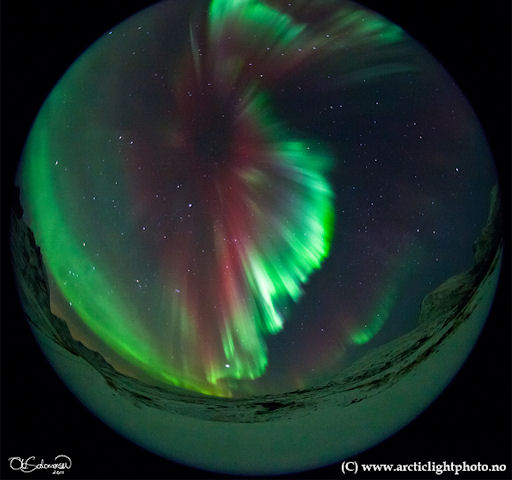
http://science.nasa.gov/science-news/science-at-nasa/2010/13dec_globaleruption/
_________________
What is life?
It is the flash of a firefly in the night, the breath of a buffalo in the wintertime. It is the little shadow which runs across the grass and loses itself in the sunset.
With deepest respect ~ Aloha & Mahalo, Carol

Carol- Admin

- Posts : 31699
Join date : 2010-04-07
Location : Hawaii
- Post n°61
 Re: SOHO LASCO C2 Latest Image
Re: SOHO LASCO C2 Latest Image

"The auroras were so vibrant and swirly, that I thought I was in a scene from Harry Potter!" says Cox.
Auroras from the CME impact are subsiding, but another display is in the offing. Earth is entering a solar wind stream that could re-energize geomagnetic activity around the poles. High-latitude sky watchers should remain alert for auroras. Solar wind speed: 485.4 km/sec
VIDEO: https://www.youtube.com/watch?feature=player_embedded&v=NU18X4UHZXs
Massive Far-Side Coronal Mass Ejection (CME) and a possible Earth Directed CME were caught Dec 1st, 2011
Massive Far-Side Coronal Mass Ejection (CME) and a possible Earth Directed CME were caught Dec 1st, 2011
solarwatcher website
http://solarwatcher.net
Soho Website
http://sohowww.nascom.nasa.gov/
Solar Soft website
http://www.lmsal.com/solarsoft/latest_events/
WSA-Enlil Solar Wind Prediction
http://www.swpc.noaa.gov/wsa-enlil/cme-based/
Helioviewer
http://www.helioviewer.org/
Quality Solar Website
http://www.solarham.com
Estimated Planetary K index information
http://www.swpc.noaa.gov/rt_plots/kp_...
GOES Xray Flux Data
http://www.swpc.noaa.gov/rt_plots/xray_5mBL.html
Sunspot Information from Solar Monitor
http://www.solarmonitor.org/
Earthquake Forecasting Channel
https://www.youtube.com/thebarcaroller
Quality Weather Website
http://www.westernpacificweather.com
Space Weather Website
http://www.spaceweather.com/
_________________
What is life?
It is the flash of a firefly in the night, the breath of a buffalo in the wintertime. It is the little shadow which runs across the grass and loses itself in the sunset.
With deepest respect ~ Aloha & Mahalo, Carol

Carol- Admin

- Posts : 31699
Join date : 2010-04-07
Location : Hawaii
- Post n°62
 Re: SOHO LASCO C2 Latest Image
Re: SOHO LASCO C2 Latest Image
MASSIVE CME - Will Hit Earth Nov 29-30
FLATLINED: With no strong flares this week, the sun's x-ray output has nearly flatlined. The quiet is expected to continue for another 24+ hours. NOAA forecasters estimate a mere 20% chance of M-class solar flares.

PHOBOS GRUNT UPDATE: Russia's Mars probe, Phobos-Grunt, remains stuck in low Earth orbit after its main engines failed to fire on Nov. 8th. Russian and ESA antennas have made intermittant radio contact with the probe, but this has not allowed Roscosmos, the Russian space agency, to re-establish control. Unless matters improve, Phobos-Grunt will re-enter the atmosphere in January or February 2012 and become a brilliant fireball over some part of Earth
_________________
What is life?
It is the flash of a firefly in the night, the breath of a buffalo in the wintertime. It is the little shadow which runs across the grass and loses itself in the sunset.
With deepest respect ~ Aloha & Mahalo, Carol

Carol- Admin

- Posts : 31699
Join date : 2010-04-07
Location : Hawaii
- Post n°63
 Re: SOHO LASCO C2 Latest Image
Re: SOHO LASCO C2 Latest Image
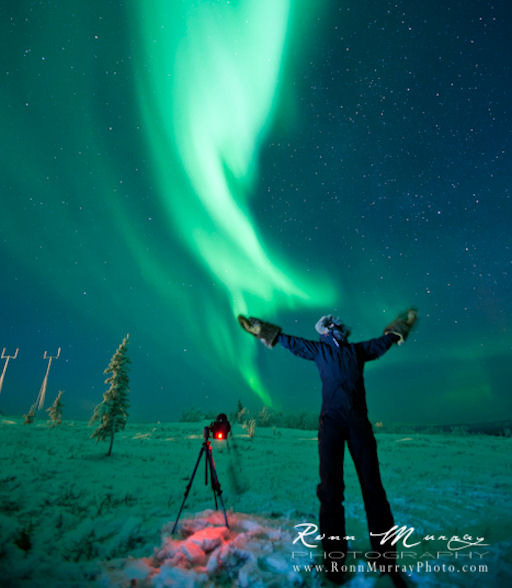
"I photographed my friend Marketa enjoying the view during a very beautful spell of auroras," says Murray.
ERUPTING FILAMENT: Today, with little warning, a magnetic filament rapidly erupted on the sun. Between 10:30 and 11:30 UT, observers in Europe watched tendrils of hot plasma rocket away from the sun's NW limb. Debris from the explosion is not expected to hit Earth. Images: #1, #2, #3.
http://spaceweather.com/submissions/large_image_popup.php?image_name=David-Evans-20111203_1322918293.jpg
SUPER-SIZED ECLIPSE: On Saturday morning, Dec. 10th, sky watchers in the western United States and Canada will witness a total lunar eclipse swollen to super-sized proportions by the Moon illusion. Get the full story from Science@NASA.
NORTHERN LIGHTS: Auroras are flickering around the Arctic Circle in response to a minor solar wind stream, which is buffeting Earth's magnetic field.
_________________
What is life?
It is the flash of a firefly in the night, the breath of a buffalo in the wintertime. It is the little shadow which runs across the grass and loses itself in the sunset.
With deepest respect ~ Aloha & Mahalo, Carol

Carol- Admin

- Posts : 31699
Join date : 2010-04-07
Location : Hawaii
- Post n°64
 Re: SOHO LASCO C2 Latest Image
Re: SOHO LASCO C2 Latest Image
Stormy sun could knock out power grids: report
LONDON, Dec. 2, 2011 (Reuters) — An upcoming cycle of stormy solar activity risks causing damage to electrical transformers and threatening vulnerable energy infrastructure around the globe, a report by an insurance group says.
The sun follows a predictable 11 year activity cycle, with the next period of stormy activity expected to begin in 2012-13.
The report by German insurance group Allianz said a high impact solar storm, not easily predicted due to its recorded rarity, could cause blackouts and economic losses of over $1 trillion and that the worst case scenario would be even worse.
"What we're coming into at the moment is the bad (space)weather period," Jim Wild of Britain's Lancaster University, an expert in solar plasma physics, told Reuters.
A large explosion on the surface of the sun could release billions of tones of superheated magnetically charged gas at a speed of a million miles per hour, and when that gas hits the earth's magnetic field, it can trigger a big solar storm.
The severity of a potential disruption has made experts at insurance and national security institutions take notice.
"When you start to imagine not having electricity in a sizeable fraction of a country or a continent for weeks or even months ... it's serious business," Wild said.
SMALL LEAD TIME
The difficulty lies in predicting how often serious solar type events occur.
The small lead time given by satellites is also a problem for preventing solar storm damage, as currently no satellite is close enough to the sun to give more than an hour's warning, Wild said.
Updating the satellites to give the earth more preparation time would cost around $1 billion, he added.
Space weather is a relatively new area of study, with sophisticated observations going back only 50 years and lacking an international coordinated tracking system such as that found with normal meteorological weather.
"We have very little on a solar time scale," Wild said.
The most damaging storm in recent memory was a 1989 outage in Quebec, Canada, which affected six million people.
The first scientific recording of a large solar storm was made in 1859 by English astronomer Richard Carrington, who observed a white light explosion on the surface of the sun.
Wild said: "what they didn't know back then was why about two or three days later you could see the northern lights over Cuba and all of the telegraph system was disrupted by geomagnetic activity."
According to the Allianz report, an event on the same scale today would cause extensive damage to electrical infrastructure.
LONDON, Dec. 2, 2011 (Reuters) — An upcoming cycle of stormy solar activity risks causing damage to electrical transformers and threatening vulnerable energy infrastructure around the globe, a report by an insurance group says.
The sun follows a predictable 11 year activity cycle, with the next period of stormy activity expected to begin in 2012-13.
The report by German insurance group Allianz said a high impact solar storm, not easily predicted due to its recorded rarity, could cause blackouts and economic losses of over $1 trillion and that the worst case scenario would be even worse.
"What we're coming into at the moment is the bad (space)weather period," Jim Wild of Britain's Lancaster University, an expert in solar plasma physics, told Reuters.
A large explosion on the surface of the sun could release billions of tones of superheated magnetically charged gas at a speed of a million miles per hour, and when that gas hits the earth's magnetic field, it can trigger a big solar storm.
The severity of a potential disruption has made experts at insurance and national security institutions take notice.
"When you start to imagine not having electricity in a sizeable fraction of a country or a continent for weeks or even months ... it's serious business," Wild said.
SMALL LEAD TIME
The difficulty lies in predicting how often serious solar type events occur.
The small lead time given by satellites is also a problem for preventing solar storm damage, as currently no satellite is close enough to the sun to give more than an hour's warning, Wild said.
Updating the satellites to give the earth more preparation time would cost around $1 billion, he added.
Space weather is a relatively new area of study, with sophisticated observations going back only 50 years and lacking an international coordinated tracking system such as that found with normal meteorological weather.
"We have very little on a solar time scale," Wild said.
The most damaging storm in recent memory was a 1989 outage in Quebec, Canada, which affected six million people.
The first scientific recording of a large solar storm was made in 1859 by English astronomer Richard Carrington, who observed a white light explosion on the surface of the sun.
Wild said: "what they didn't know back then was why about two or three days later you could see the northern lights over Cuba and all of the telegraph system was disrupted by geomagnetic activity."
According to the Allianz report, an event on the same scale today would cause extensive damage to electrical infrastructure.
_________________
What is life?
It is the flash of a firefly in the night, the breath of a buffalo in the wintertime. It is the little shadow which runs across the grass and loses itself in the sunset.
With deepest respect ~ Aloha & Mahalo, Carol

Carol- Admin

- Posts : 31699
Join date : 2010-04-07
Location : Hawaii
- Post n°65
 Re: SOHO LASCO C2 Latest Image
Re: SOHO LASCO C2 Latest Image
GROWING THREAT OF FLARES: What a difference a weekend makes. Since Friday, sunspot AR1363 has nearly tripled in area and it has developed a delta-class magnetic field that harbors energy for X-class solar flares. This 48-hour movie from NASA's Solar Dynamic Observatory shows the changes on Dec. 3-4:

Despite its growing potential for explosions, the sunspot remains mostly quiet producing no flares stronger than C-class. Is this the quiet before the storm--or just plain quiet? Stay tuned.
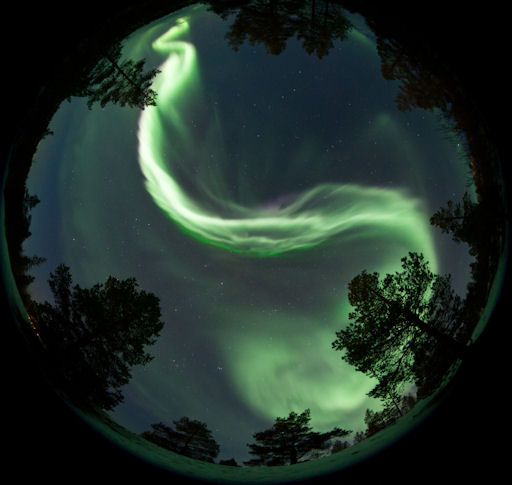 AURORA EXPLOSION: Saturday night on the border between Russia and Norway, the sky suddenly erupted in color. "It was like an aurora explosion," says
AURORA EXPLOSION: Saturday night on the border between Russia and Norway, the sky suddenly erupted in color. "It was like an aurora explosion," says
Sebastian Voltmer of Kirkenes, Norway. "I was surprised to see a brightening snake forming an 'S' - like the first letter of my name, that appeared at 22.48 pm UT."

Despite its growing potential for explosions, the sunspot remains mostly quiet producing no flares stronger than C-class. Is this the quiet before the storm--or just plain quiet? Stay tuned.

Sebastian Voltmer of Kirkenes, Norway. "I was surprised to see a brightening snake forming an 'S' - like the first letter of my name, that appeared at 22.48 pm UT."
_________________
What is life?
It is the flash of a firefly in the night, the breath of a buffalo in the wintertime. It is the little shadow which runs across the grass and loses itself in the sunset.
With deepest respect ~ Aloha & Mahalo, Carol

Carol- Admin

- Posts : 31699
Join date : 2010-04-07
Location : Hawaii
- Post n°66
 Re: SOHO LASCO C2 Latest Image
Re: SOHO LASCO C2 Latest Image
VIDEO: https://www.youtube.com/watch?feature=player_embedded&v=lwgzbZlagHI
Solar flare could disrupt Earth communications
Solar flare could disrupt Earth communications
An unusual solar flare observed by a NASA space observatory could cause some disruptions to satellite communications and power on Earth over the next day or so, officials have said. The potent blast from the Sun unleashed a firestorm of radiation on a level not witnessed since 2006, and will likely lead to moderate geomagnetic storm activity by Wednesday, according to the National Weather Service.
***NEW UPDATE*** NASA has revised their prediction for solar maximum to now occur around mid-May of 2013. sources:
http://www.nasa.gov/mission_pages/sunearth/news/next-solarstorm.html
https://www.youtube.com/watch?v=4_TzIUlaQok
Solar SuperStorm 1859 -- It could happen again
http://modernsurvivalblog.com/solar-cycle/solar-superstorm-1859-it-can-happen...
http://science.nasa.gov/science-news/science-at-nasa/2006/10mar_stormwarning/
http://science.nasa.gov/science-news/science-at-nasa/2009/01apr_deepsolarmini...
http://science.nasa.gov/science-news/science-at-nasa/2009/29may_noaaprediction/
Solar physicist David Hathaway of the National Space Science & Technology Center (NSSTC) explains: "First, remember what sunspots are--tangled knots of magnetism generated by the sun's inner dynamo. A typical sunspot exists for just a few weeks. Then it decays, leaving behind a 'corpse' of weak magnetic fields."
Enter the conveyor belt.
"The top of the conveyor belt skims the surface of the sun, sweeping up the magnetic fields of old, dead sunspots. The 'corpses' are dragged down at the poles to a depth of 200,000 km where the sun's magnetic dynamo can amplify them. Once the corpses (magnetic knots) are reincarnated (amplified), they become buoyant and float back to the surface." Presto—new sunspots!
Right: The sun's "great conveyor belt."
All this happens with massive slowness. "It takes about 40 years for the belt to complete one loop," says Hathaway. The speed varies "anywhere from a 50-year pace (slow) to a 30-year pace (fast)."
When the belt is turning "fast," it means that lots of magnetic fields are being swept up, and that a future sunspot cycle is going to be intense. This is a basis for forecasting: "The belt was turning fast in 1986-1996," says Hathaway. "Old magnetic fields swept up then should re-appear as big sunspots in 2010-2011."
Like most experts in the field, Hathaway has confidence in the conveyor belt model and agrees with Dikpati that the next solar maximum should be a doozy. But he disagrees with one point. Dikpati's forecast puts Solar Max at 2012. Hathaway believes it will arrive sooner, in 2010 or 2011.
"History shows that big sunspot cycles 'ramp up' faster than small ones," he says. "I expect to see the first sunspots of the next cycle appear in late 2006 or 2007—and Solar Max to be underway by 2010 or 2011."
Who's right? Time will tell. Either way, a storm is coming...
A massive eruption of the sun would save waves of radiation and charged particles to Earth, damaging the satellite systems used for synchronising computers, airline navigation and phone.
https://www.youtube.com/watch?v=4_TzIUlaQok&feature=related
music: Andromeda artist: Doc album: Cosmic Lullabies
http://www.jamendo.com/en/album/18115
_________________
What is life?
It is the flash of a firefly in the night, the breath of a buffalo in the wintertime. It is the little shadow which runs across the grass and loses itself in the sunset.
With deepest respect ~ Aloha & Mahalo, Carol

Carol- Admin

- Posts : 31699
Join date : 2010-04-07
Location : Hawaii
- Post n°67
 Re: SOHO LASCO C2 Latest Image
Re: SOHO LASCO C2 Latest Image

Every night the network's cameras scan the skies over the United States, forming an inventory of what hits the atmosphere. Combining images from multiple cameras, network software rapidly calculates the basic parameters of each interloper: orbit, speed, disintegration height, and more. At the moment, cameras are located in only four states (New Mexico, Alabama, Georgia, Tennessee), but the network is expanding to provide even better coverage. Soon we'll see just how congested our intersection in space really is. http://www.spaceweather.com/
_________________
What is life?
It is the flash of a firefly in the night, the breath of a buffalo in the wintertime. It is the little shadow which runs across the grass and loses itself in the sunset.
With deepest respect ~ Aloha & Mahalo, Carol

Carol- Admin

- Posts : 31699
Join date : 2010-04-07
Location : Hawaii
- Post n°68
 Re: SOHO LASCO C2 Latest Image
Re: SOHO LASCO C2 Latest Image
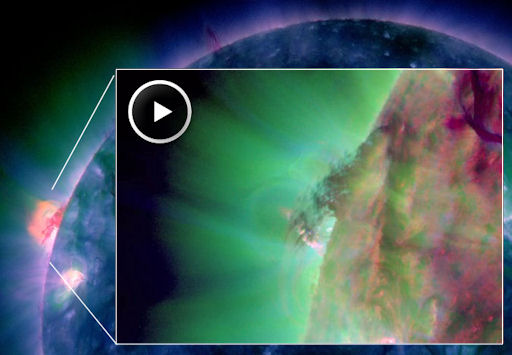
_________________
What is life?
It is the flash of a firefly in the night, the breath of a buffalo in the wintertime. It is the little shadow which runs across the grass and loses itself in the sunset.
With deepest respect ~ Aloha & Mahalo, Carol

Carol- Admin

- Posts : 31699
Join date : 2010-04-07
Location : Hawaii
- Post n°69
 Re: SOHO LASCO C2 Latest Image
Re: SOHO LASCO C2 Latest Image
The Sun blasted off a number of coronal mass ejections in just over two days (Dec. 7-9, 2011) by SOHO's C2 coronagraph. We superimposed the Sun from the Solar Dynamics Observatory to show what the Sun was doing during the same time frame. The first blast was determined to have originated on the far side of the Sun. The final, good-sized blast (lower left) was caused by the looping prominence eruption visible in the Sun image. The overall level of solar activity continues to increase as the Sun approaches its peak period activity called solar maximum, expected in 2013.

SOLAR WIND - Speed: 453.4 km/s
SOLAR WIND: A minor solar wind stream is buffeting Earth's magnetic field. Arctic sky watchers should be alert for auroras.
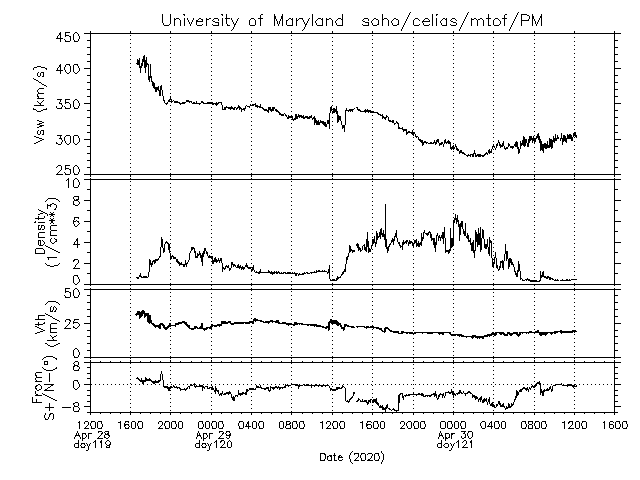
Proton Monitor

SOLAR WIND - Speed: 453.4 km/s
SOLAR WIND: A minor solar wind stream is buffeting Earth's magnetic field. Arctic sky watchers should be alert for auroras.

Proton Monitor
_________________
What is life?
It is the flash of a firefly in the night, the breath of a buffalo in the wintertime. It is the little shadow which runs across the grass and loses itself in the sunset.
With deepest respect ~ Aloha & Mahalo, Carol

Carol- Admin

- Posts : 31699
Join date : 2010-04-07
Location : Hawaii
- Post n°70
 Re: SOHO LASCO C2 Latest Image
Re: SOHO LASCO C2 Latest Image
SIGNIFICANT COMET PLUNGES TOWARD THE SUN: A comet nearly as wide as two football fields (200m) is plunging toward the sun where it will most likely be destroyed in a spectacular light show on Dec. 15/16. Although Comet Lovejoy (C/2011 W3) could become as bright as Jupiter or Venus when it "flames out," the glare of the sun will hide the event from human eyes. Solar observatories in space, however, will have a grand view. Yesterday the brightening comet entered the field of view of NASA's STEREO-B spacecraft:
 "You can clearly see the comet heading diagonally through the images," says Karl Battams of the Naval Research Lab who prepared the animation. "During the 16-hour sequence, the comet brightens from magnitude +8 to +6.5, approximately."
"You can clearly see the comet heading diagonally through the images," says Karl Battams of the Naval Research Lab who prepared the animation. "During the 16-hour sequence, the comet brightens from magnitude +8 to +6.5, approximately."
It will soon grow much brighter. "This comet is a true sungrazer, and will skim approximately 140,000 km (1.2 solar radii) above the solar surface on Dec. 15/16," notes Battams. At such close range, solar heating will almost certainly destroy the icy interloper,creating a cloud of vapor and comet dust that will reflect lots of sunlight. The Solar and Heliospheric Observatory (SOHO) will have a particularly good view.
GEMINID METEOR SHOWER: The Geminid meteor shower peaks on Dec. 13th and 14th. Bright moonlight will interfere with the display, but not obliterate it. Forecasters expect observers with clear skies to see as many as 40 meteors per hour. The best time to look, no matter where you live, is between 10 pm local time on Tuesday, Dec. 13, and sunrise on Wednesday, Dec. 14th.
 AURORA WATCH: A solar wind stream is buffeting Earth's magnetic field, causing mild geomagnetic disturbances and auroras around the Arctic Circle.
AURORA WATCH: A solar wind stream is buffeting Earth's magnetic field, causing mild geomagnetic disturbances and auroras around the Arctic Circle.

It will soon grow much brighter. "This comet is a true sungrazer, and will skim approximately 140,000 km (1.2 solar radii) above the solar surface on Dec. 15/16," notes Battams. At such close range, solar heating will almost certainly destroy the icy interloper,creating a cloud of vapor and comet dust that will reflect lots of sunlight. The Solar and Heliospheric Observatory (SOHO) will have a particularly good view.
GEMINID METEOR SHOWER: The Geminid meteor shower peaks on Dec. 13th and 14th. Bright moonlight will interfere with the display, but not obliterate it. Forecasters expect observers with clear skies to see as many as 40 meteors per hour. The best time to look, no matter where you live, is between 10 pm local time on Tuesday, Dec. 13, and sunrise on Wednesday, Dec. 14th.

_________________
What is life?
It is the flash of a firefly in the night, the breath of a buffalo in the wintertime. It is the little shadow which runs across the grass and loses itself in the sunset.
With deepest respect ~ Aloha & Mahalo, Carol

Carol- Admin

- Posts : 31699
Join date : 2010-04-07
Location : Hawaii
- Post n°71
 Re: SOHO LASCO C2 Latest Image
Re: SOHO LASCO C2 Latest Image

http://spaceweather.com/
Small chance doomed Comet Lovejoy may appear as faint light near the Sun from Earth
GEMINID FIREBALLS: On the night of Dec. 13/14, NASA's All-Sky Meteor Network recorded 35 fireballs streaking over the southern USA. Twenty-two of them had remarkably similar orbits:

NASA's fireball network, which connects multiple cameras in New Mexico, Alabama, Georgia and Tennessee, is a "smart" system. It rapidly and autonomously calculates meteoroid orbits from the fireballs it records. Another orbit diagram is just hours away.
_________________
What is life?
It is the flash of a firefly in the night, the breath of a buffalo in the wintertime. It is the little shadow which runs across the grass and loses itself in the sunset.
With deepest respect ~ Aloha & Mahalo, Carol

Carol- Admin

- Posts : 31699
Join date : 2010-04-07
Location : Hawaii
- Post n°72
 Re: SOHO LASCO C2 Latest Image
Re: SOHO LASCO C2 Latest Image
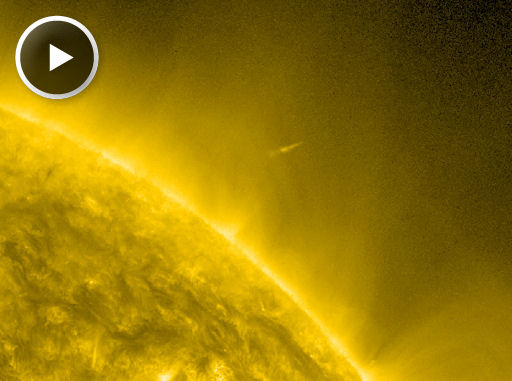
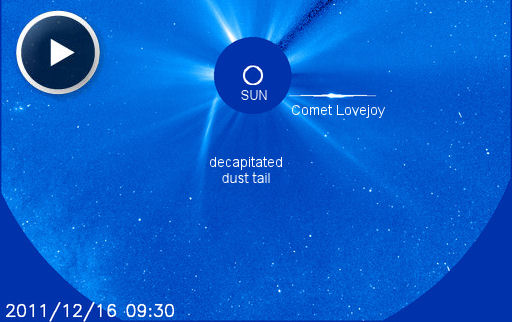
Curiously, the comet seems to have lost its tail in transit through the sun's hot corona. A decapitated remnant tail can still be seen tracing Comet Lovejoy's path into the sun, but the exiting comet has no obvious trail of dust behind it. One possibility has to do with geometry: The comet's tail might be pointing away from Earth, temporarily invisible due to foreshortening. Another possibility: The comet's store of volatile materials was "baked-out" by the fiery transit and now the comet is not jetting much dust and gas into space.
CURIOSITY AND THE SOLAR STORM: Last month, a massive solar storm launched itself toward Mars just as NASA's new rover, Curiosity, was blasting off from Cape Canaveral in the same direction. Researchers say it was a welcome coincidence. For the first time in Mars-rover history, Curiosity is equipped to study solar storms, and it will be monitoring space weather all the way to the Red Planet.
_________________
What is life?
It is the flash of a firefly in the night, the breath of a buffalo in the wintertime. It is the little shadow which runs across the grass and loses itself in the sunset.
With deepest respect ~ Aloha & Mahalo, Carol

Carol- Admin

- Posts : 31699
Join date : 2010-04-07
Location : Hawaii
- Post n°73
 Re: SOHO LASCO C2 Latest Image
Re: SOHO LASCO C2 Latest Image
https://www.youtube.com/watch?feature=player_embedded&v=fFC2IU-O8M0
NASA | SDO Sees Comet Lovejoy Survive Close Encounter with Sun
One instrument watching for the comet was the Solar Dynamics Observatory (SDO), which adjusted its cameras in order to watch the trajectory. Not only does this help with comet research, but it also helps orient instruments on SDO -- since the scientists know where the comet is based on other spacecraft, they can finely determine the position of SDO's mirrors. This first clip from SDO from the evening of Dec 15, 2011 shows Comet Lovejoy moving in toward the sun.
Comet Lovejoy survived its encounter with the sun. The second clip shows the comet exiting from behind the right side of the sun, after an hour of travel through its closest approach to the sun. By tracking how the comet interacts with the sun's atmosphere, the corona, and how material from the tail moves along the sun's magnetic field lines, solar scientists hope to learn more about the corona. This movie was filmed by the Solar Dynamics Observatory in 171 Angstrom wavelength, which is typically shown in yellow.
Credit: NASA/SDO
This video is public domain.
Like our videos? Subscribe to NASA's Goddard Shorts HD podcast:
http://svs.gsfc.nasa.gov/vis/iTunes/f0004_index.html
Or find NASA Goddard Space Flight Center on Facebook:
https://www.facebook.com/NASA.GSFC
_________________
What is life?
It is the flash of a firefly in the night, the breath of a buffalo in the wintertime. It is the little shadow which runs across the grass and loses itself in the sunset.
With deepest respect ~ Aloha & Mahalo, Carol

gscraig- Posts : 270
Join date : 2010-04-12
- Post n°74
 Re: SOHO LASCO C2 Latest Image
Re: SOHO LASCO C2 Latest Image
Perhaps the arguement out there by some astronomists that Comets are not made of ice has just been proven?
How else can something with an ice content survive being in such close proximity of Sun?
How else can something with an ice content survive being in such close proximity of Sun?

Carol- Admin

- Posts : 31699
Join date : 2010-04-07
Location : Hawaii
- Post n°75
 Re: SOHO LASCO C2 Latest Image
Re: SOHO LASCO C2 Latest Image
CHRISTMAS EVE ERUPTION: A filament of magnetism connected to sunspot AR1386 erupted during the early hours of Dec. 24th. Extreme UV-wavelength cameras onboard the Solar Dynamics Observatory recorded the picturesque blast: The C5-class eruption hurled a billion-ton coronal mass ejection (CME) into space, but not toward Earth. With the cloud sailing wide-left of our planet, Christmas geomagnetic storms are unlikely. Nevertheless, this active region merits watching as it turns toward Earth in the days ahead, possibly positioning itself for the first storms of 2012. http://www.spaceweather.com/glossary/flareclasses.html
_________________
What is life?
It is the flash of a firefly in the night, the breath of a buffalo in the wintertime. It is the little shadow which runs across the grass and loses itself in the sunset.
With deepest respect ~ Aloha & Mahalo, Carol
» What's Coming Our Way
» Solar Observatories Around The World And SOHO All Taken Offline At The Same Time
» Giant UFOs and Anomalies near the Sun - NASA SOHO satellite images HQ - August 29, 2012.
» IMAGE FILE: Holocaust Innuendo in the still from the Disney cartoon Chip 'n Dale
» Biggest Ever Image of Night Sky
» Solar Observatories Around The World And SOHO All Taken Offline At The Same Time
» Giant UFOs and Anomalies near the Sun - NASA SOHO satellite images HQ - August 29, 2012.
» IMAGE FILE: Holocaust Innuendo in the still from the Disney cartoon Chip 'n Dale
» Biggest Ever Image of Night Sky











